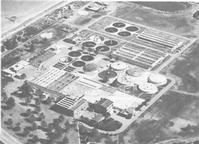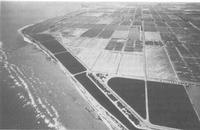


Chapter 3
I Background
II Early European Settlements
III Assessment Of Available Water Resources
IV Water Supplies For Goldmining Development
V Irrigation Development
VI Farm And Stock Water Supplies
VII Urban Water Supplies
VIII Wastewater Management And Treatment
i Treatment processes
ii Re-use of effluent
IX Water Quality Management
X Limnological And Water Quality Research
XI New Techniques In Water Resource Planning And Management
XII Legislation
XIII Conclusion
XIV List Of Abbreviations
XV Acknowledgements
XVI Plantations-high Productivity Resources
References
Index
Search
Help
Contact us

Treatment processes
Almost all major urban cities are fully sewered. Partly because of the general shortage of water and erratic streamflow in rivers into which effluents were discharged, most had some form of secondary treatment from their inception, with some significant exceptions such as the large raw sewage outfalls of the Sydney area. Overseas processes such as biological filters (in the earlier years) and activated sludge treatment (in more recent years) have been applied to the major centres in a generally efficient manner, but there has been only a small volume of local adaptation or improvement.Adelaide was the first city in Australia to adopt the activated sludge process and local engineers have made significant improvements to the energy recovery stage of the process, using combustible gases produced during sludge digestion to generate electricity for the operation of the plant (Fig. 13).

By contrast, in rural areas with ample space and favourable climate, the economical lagoon treatment of sewage has been widely used (except in States where local dogma precludes its use). There has been a large degree of local adaptation of this process, which features low-cost operation. Recent research in Victoria has also indicated a high degree of virus removal in lagoon systems.
Another process successfully modified for local use, principally in New South Wales, is the Pasveer intermittent oxidation ditch, which is particularly suitable for small communities of up to 3,000 people. Over 50 of these plants are operating in New South Wales alone. For medium-sized plants, the aerated ditch activated sludge process has been successfully adapted for Australian conditions and more than 20 plants are now in operation, for communities of up to 50,000 persons.
Package plants are included here because of their wide usage to solve a temporary problem, rather than as a technological innovation. The lack of sewer construction during the World Wars and periods of economic depression led to extensive environmental damage and deterioration of water quality in metropolitan waterways. Correction of this situation was begun in the 1960s, when land developers were required to provide sewers and other essential services, and to treat the resultant wastes before the ultimate receiving and treatment facilities could be provided. Sophisticated package plants employing the activated sludge treatment process were widely employed, with some local adaptation and considerable success.
A considerable volume of innovative work has been done in Australia to improve the performance, especially the land-use efficiency, of broad-acre land treatment, the oldest treatment system in the world. The basic system of land filtration, where sewage is applied to land to grow grass, has the disadvantage that, in the winter, when the land least needs the application of sewage, the volume to be treated is the greatest. This problem led to the development at Melbourne's Werribee Sewerage Farm of systems of grass filtration where the sewage is run over rather than into the land, and the grass is used to increase the area of exposure to light and air. The Werribee plant, with its combination of land treatment and lagoons, was conceived in the 1880s and currently treats about 400 ML/d. It is one of the principal land treatment systems in the world. (Fig. 14)

Organisations in Australian Science at Work - Glenelg Sewage Treatment Works, S.A.; Werribee Sewerage Treatment Farm, Vic.
 |
Australian Academy of Technological Sciences and Engineering |  |
© 1988 Print Edition pages 179 - 180, Online Edition 2000
Published by Australian Science and Technology Heritage Centre, using the Web Academic Resource Publisher
http://www.austehc.unimelb.edu.au/tia/184.html